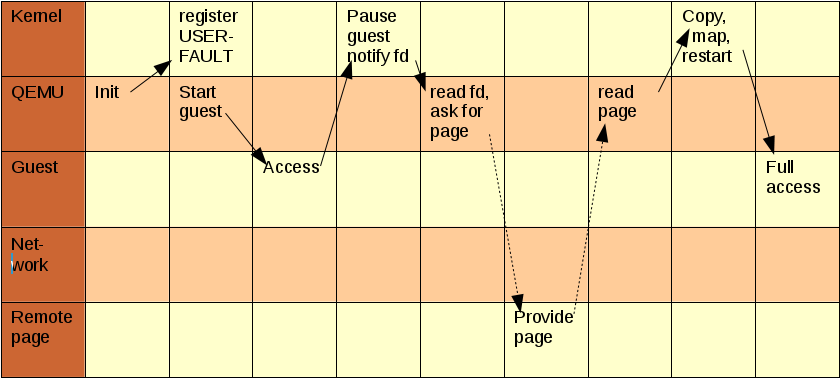Features/PostCopyLiveMigration
summary
post-copy based live migration (merged in 2.5)
owner
- Name: Dave Gilbert
- Email: dgilbert@redhat.com
Current Status
- Last updated: 2015-11-24
- Released in: QEMU 2.5
Summary
A postcopy implementation that allows migration of guests that have large page change rates (relative to the available bandwidth) to be migrated in a finite time. VMs of any size running any workload can be migrated.
How to use
Enables postcopy mode before the start of migration:
migrate_set_capability x-postcopy-ram on
Start the migration as normal:
migrate tcp:destination:port
Change into postcopy mode; this can be issued any time after the start of migration, for most workloads it's best to wait until one cycle of RAM migration has completed (i.e. the sync count hits 2 in info migrate).
migrate_start_postcopy
Design
This postcopy implementation uses the Linux 'userfault' and kernel mechanisms from Andrea Arcangeli; it's not specific to Postcopy and is designed to allow use with all of the standard kernel features (like transparent huge pages, KSM etc). It requires Linux 4.3 or newer.
Mixed pre/post copy is built into the design from the start; a command is sent to switch modes after the migration has been stated (as long as postcopy mode has been enabled first by a capability)
The guest page faults are asynchronous, so that multiple page faults can be outstanding at once allowing useful work to continue inspite of the latency of providing the page.
Major components
Where possible the design attempts to build reusable components that other features can reuse.
- 'command' section type for sending migration commands that don't directly reflect guest state; this is used to send messages that move through different phases of postcopy and is expandable for use by others.
- 'return path' a method for the destination to send messages back to the source; used for postcopy page requests, and allows the destination to signal failure back to the source; this is currently supported on TCP and fd (where the fd is socket backed).
- 'sent map' a bitmap on the source populated with the set of all pages that have already been transmitted
- 'postcopy pagemap inbound (PMI)' a map on the destination holding the state of each page, whether it's been requested from the source and whether it has been received.
Other than the 'command' section, the outgoing migration protocol is unchanged.
TODO
future enhancement
- optimization - rate limit the background page transmission to reduce the impact on the latency of postcopy page requests.
- Integration with RDMA
- Handle huge pages & mappings from files.

